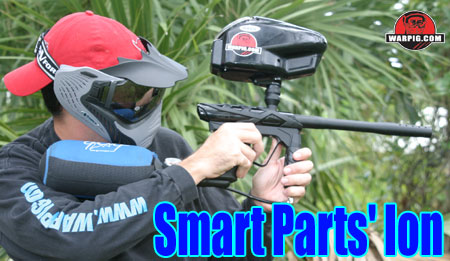  |
|
|
|
|
|
|
  |
|
|
|
|
|
|

What
do you think?
|

Smart Parts' Ion How it Works By Bill Mills - Photos by Dawn Mills - Aug 2005 Overview - How It Works - Disassembly - Testing - Raw Test Data
Inside the fire chamber lies the heart of the Ion, its bolt which serves as a spool valve core. In general principle the Ion functions similarly to a Shocker SFT or Matrix. In addition to chambering a ball and closing the breech, the bolt controls the flow of gas from the fire chamber (also known as an accumulator in pneumatics lingo) to the breech.
The Ion design is simpler than the Shocker or Matrix however, in that the bolt is driven forward by the pressure of the gas in the fire chamber. Instead of using control gas through a 4 way solenoid valve to move the bolt back and forth, the Ion uses a simpler control valve to either push the bolt back to the open position with gas, or to vent and allow the gas in the fire chamber to blow the bolt forward.
Installation of a 9-volt battery (included) is simple. Two Phillips head screws release one of the wraparound grip panels, and provide access to the battery storage area in the grip. The battery snaps into its battery clip and is ready to go. At the field, air a hopper and paint are all that is needed to get the Ion rolling. Pressing, and momentarily holding the power button in the Ion’s grip turns it on, with the Vision mode active. For review a Crossfire 4500 psi high output (800 psi output) compressed air system was used. Basic velocity adjustment can be achieved by changing the settings of the vertical regulator. An adjustable wrench can get a solid grip on the flats on the bottom of the regulator. It is important while adjusting, to keep an eye on the pressure gauge to make sure that 200 psi is not exceeded during set-up.
Located on the opposite side of the circuit board from the programming button are a pair of surface mounted light emitting diodes (LEDs.) These two diodes blink in various sequences to indicate programming status, while the power button is used to change the selected setting. In all there are three settings which can be adjusted on the Ion’s circuit board. Programming begins by turning on the Ion, and pressing the programming button. Each time the programming button is pressed, the setting being adjusted will be changed, and the pattern of blinking LEDs will indicate the selected setting. Each setting may be adjusted either up or down, depending on the pattern with which the LEDs are blinking.
When the programming button is first pressed, the yellow LED will light solidly, pressing the power button at this point will increase the dwell time, or the amount of time that the circuit applies power to the solenoid valve to fire a paintball. Pressing the programming button again will cause the Ion circuit board to hold the red LED on solidly. Then each press on the power button will decrease the dwell time. When a setting reaches either the bottom or top of the range over which it can be adjusted, the red LED will flash momentarily. The velocity at which a paintball is fired will depend on the fit of the ball to the barrel, the pressure of the gas (vertical regulator setting) and the dwell time for the valve. A setting of 52 is standard for the Ion dwell time, but players looking to tweak maximum gas efficiency may want to spend some time at the chrono optimizing their pressure and dwell settings. For the most part it is common practice to keep a dwell of 52 and adjust velocity with the vertical regulator.
European readers will note that the version of the Ion sold in the UK does not include full-auto or burst firing modes. UK Ions can be readily identified by their green power button LED. Because the programming button cannot be accessed on field without tools, the Ion can be field legal under most field and tournament rules which limit paintguns to semi-auto only. While an experienced referee will be able to recognize the rebound mode simply by test firing, the most certain way to verify if an Ion is in rebound or semi-auto mode is to open the grip and change the setting. |
| Copyright © 1992-2019
Corinthian Media Services. WARPIG's webmasters can be reached through our feedback form. All articles and images are copyrighted and may not be redistributed without the written permission of their original creators and Corinthian Media Services. The WARPIG paintball page is a collection of information and pointers to sources from around the internet and other locations. As such, Corinthian Media Services makes no claims to the trustworthiness or reliability of said information. The information contained in, and referenced by WARPIG, should not be used as a substitute for safety information from trained professionals in the paintball industry. |